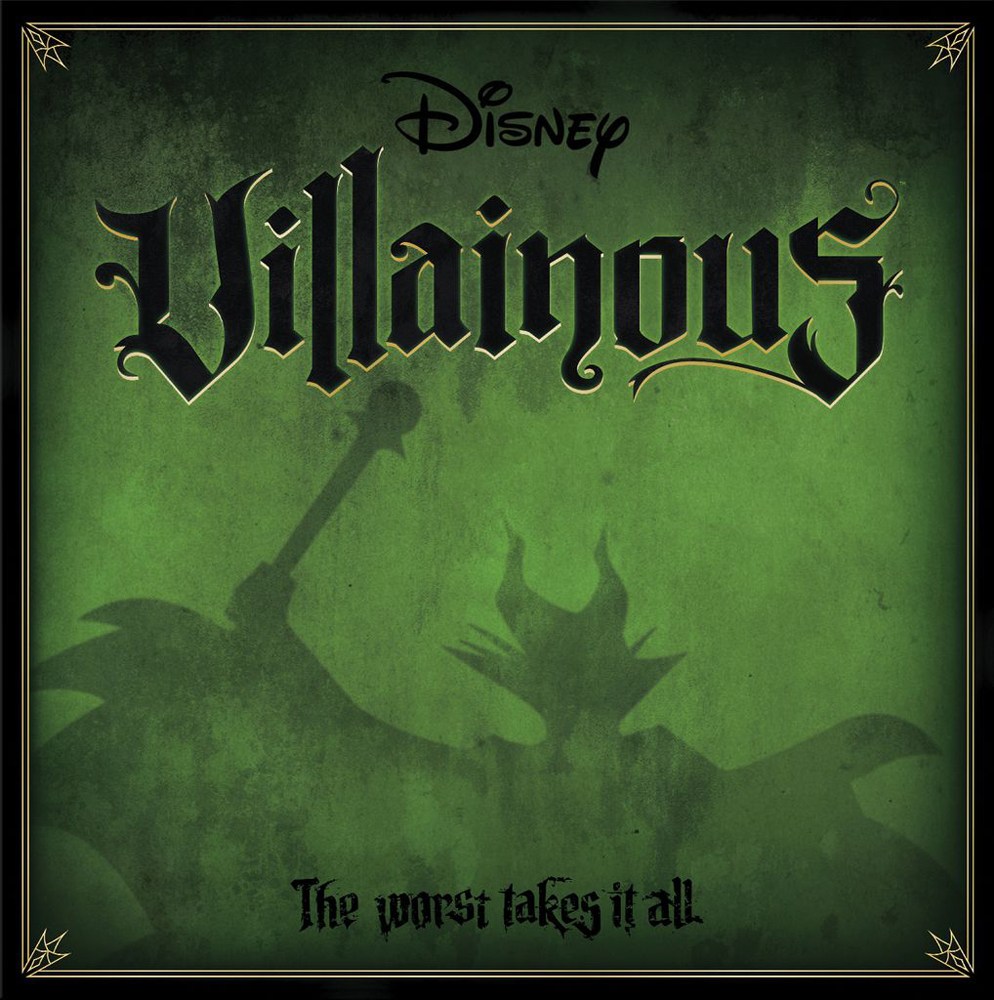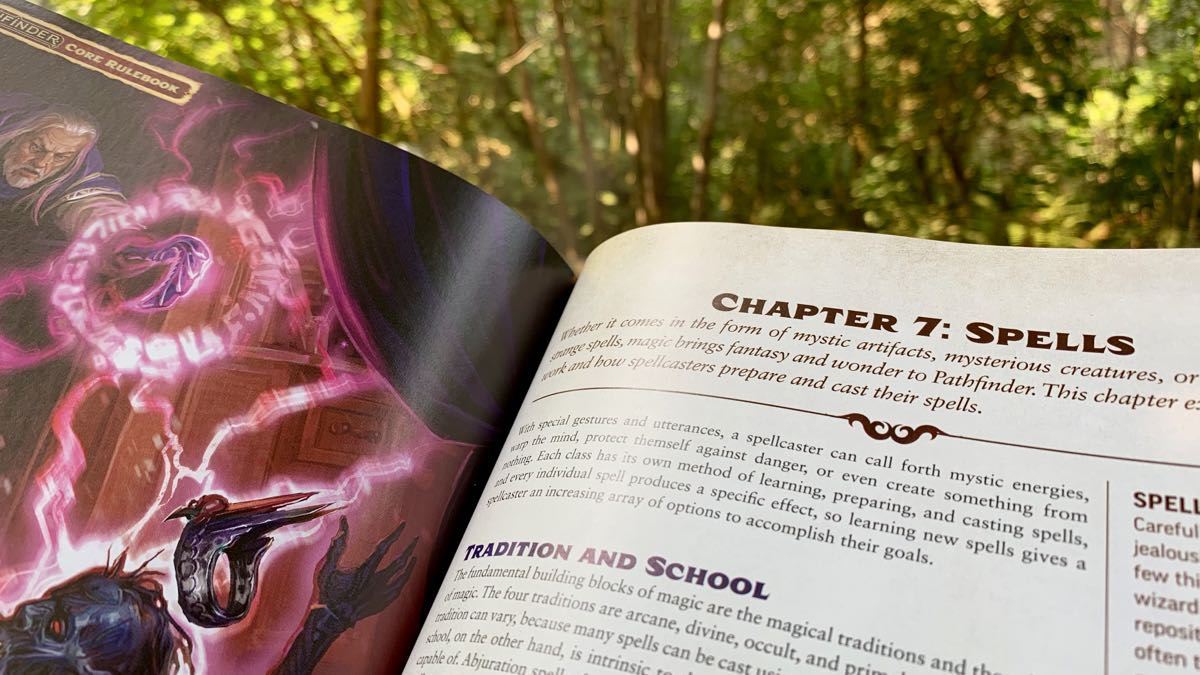If you’ve ever felt bad when Maleficent gets her comeuppance, if you just wanted Peter Pan to grow up already, if you think that Ursula was just misunderstood … Villainous is the game for you.
What Is Villainous?
Villainous is a game about Disney villains for 2 to 6 players, ages 10 and up, and takes about an hour to play. It releases August 1, with a retail price of $34.99; it will be available at Amazon, Target, Walmart, Barnes & Noble, and game stores. There’s a bit of rules-reading involved because each character has its own unique set of cards and functions, but once players are familiar with the characters, gameplay is not too difficult. Note that the more players you have, the longer the game will typically take. The game is designed by Forrest-Pruzan, a design studio that was also behind Harry Potter: Hogwarts Battle.

Villainous Components
- 6 Boards
- 6 Villain figurines
- 6 Villain decks, each with:
- 30 Villain cards
- 15 Fate cards
- 80 Power tokens
- 3 Lock tokens
- 1 Fate token
- 6 Reference Cards
- 6 Villain Guides
First off: this game looks marvelous. From the deliciously sinister green box cover (featuring Maleficent’s shadow) to the figurines to the designs on the card backs, Villainous is a game that will make people stop and say, “Ooooh, what are you playing?” That’s not to say everything is perfect, but there’s definitely a lot to like about it.
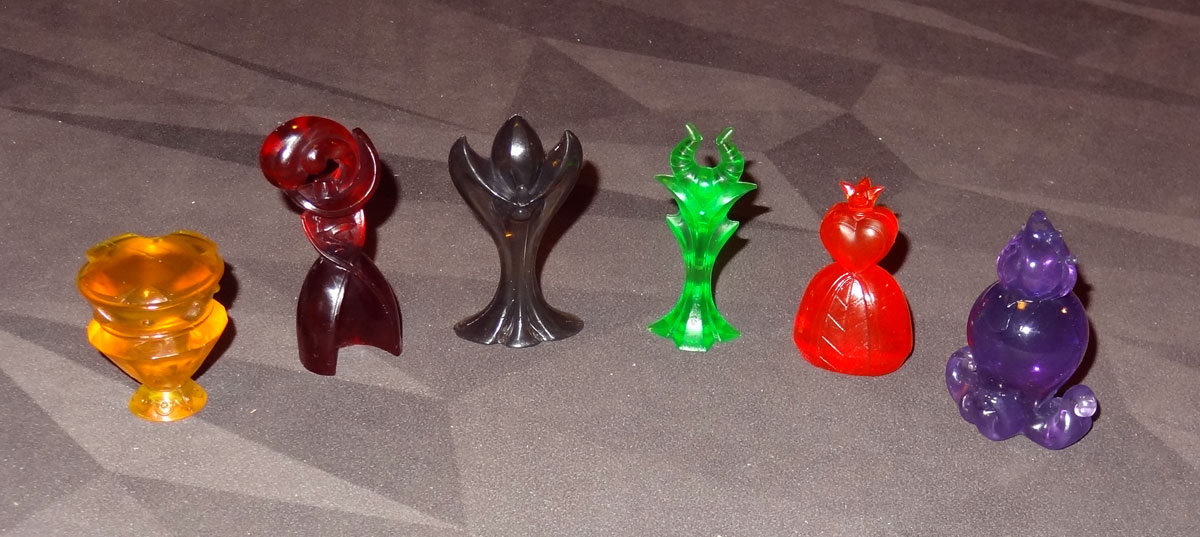
The figurines are a sort of rubbery plastic—some of the thinner pieces, like Jafar and Maleficent, are a little bendy. They’re translucent, and rather than being full depictions of the villains, they’re more like stylized representations using some of the characters’ iconic features. For instance, the Queen of Hearts has her large skirt and a heart, topped with a crown. Jafar’s recalls his silhouette with pointy shoulders, flowing robes, and towering headpiece. Captain Hook makes do with a magnificent plumed hat, ruffled collar, and sweeping coat.
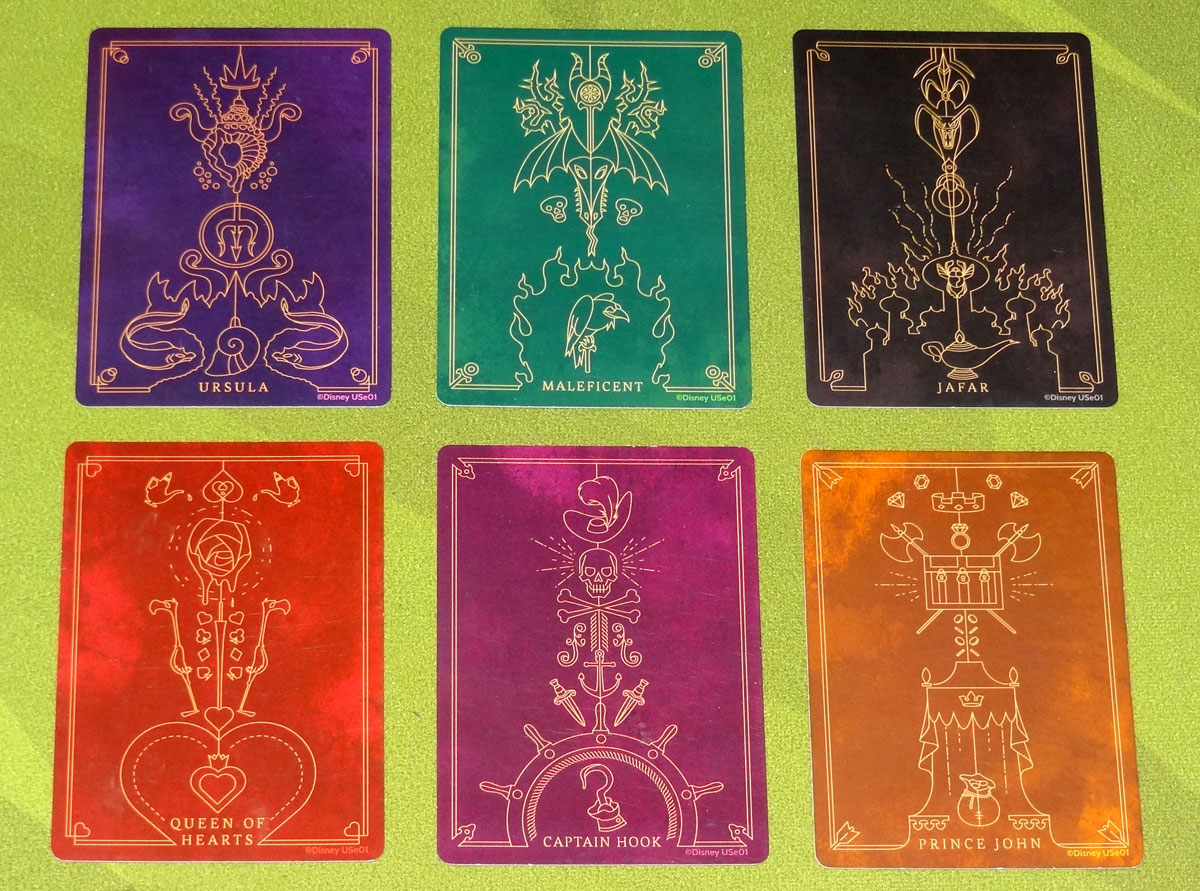
The card backs look like art posters for the various characters, each made of more iconic references to the movies. Ursula has Flotsam and Jetsam, King Triton’s crown and trident, the conch and nautilus shells, and a few tentacles for good measure. Maleficent has her horns, thorns, dragon form, and her trusty raven. The background color is a little mottled, giving it the look of an old leather-bound book, which is also a lovely touch. The Fate cards use the same patterns, but with white background.
The cards themselves feature familiar characters and items from the movies, with explanatory text below. The one unfortunate circumstance is that as you play multiple cards to your board, you will probably need to overlap them (unless you have unlimited table space), which means that you’ll cover up the artwork if you want to see the card abilities.
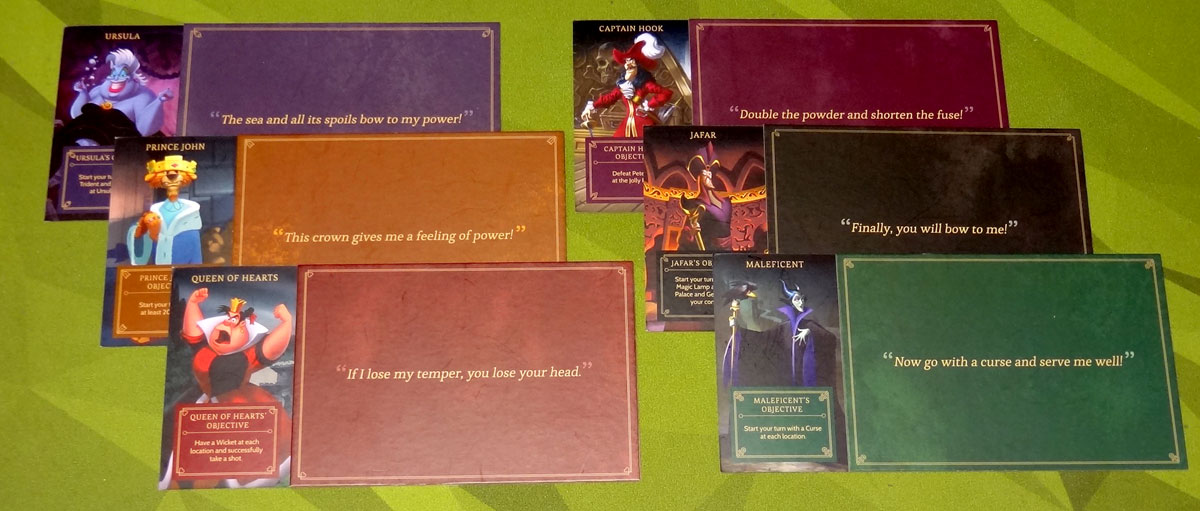
Each character has a board, showing their objective and four locations with various actions on it. It’s a nice touch that the fold is offset from the center, so that the character portrait and objective is visible when folded, and each character also gets a quote printed on the back, visible when the board is closed.
The artwork on the boards is fun, too, showing important locations from the movie. Each location has card outlines on top and below, showing where cards will be played, and the action icons are simple and easily distinguishable. The icons are all listed on the reference cards, but once you’ve played a few times you won’t even need those anymore. The reference cards also show all of the villains objectives, so you can figure out what your rivals are up to.
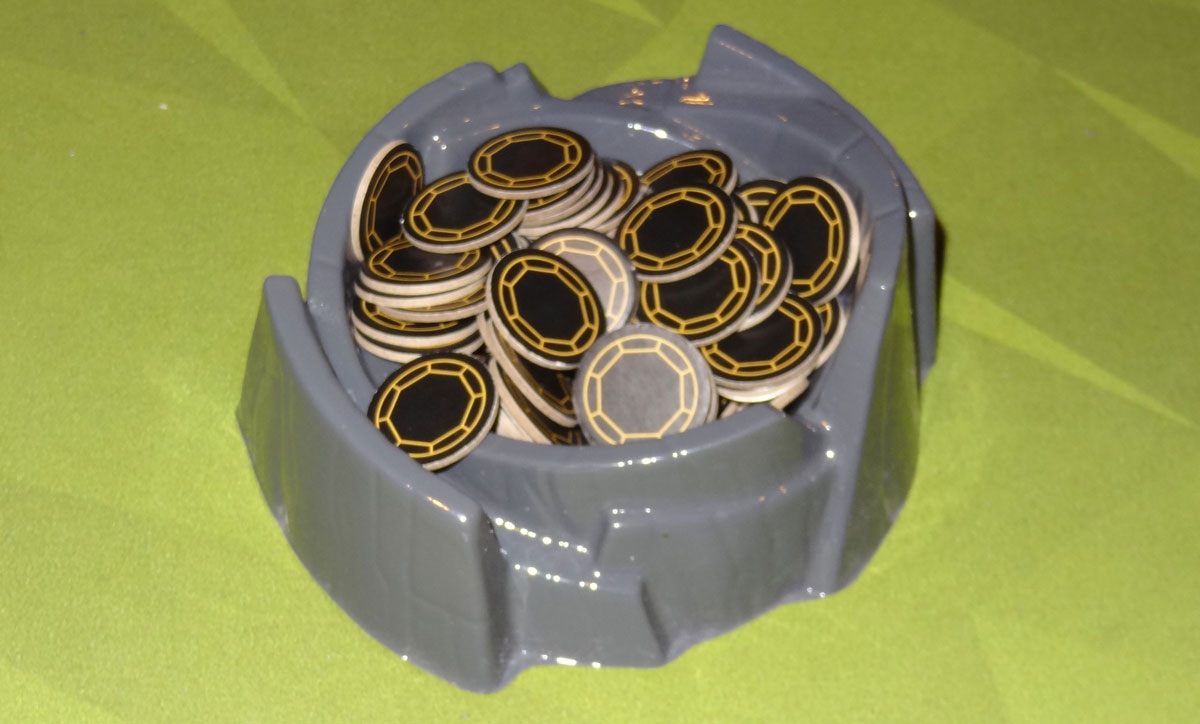
The cauldron, which holds the power tokens, is the weakest of the components. It looks all right on the table, but it’s made of very flimsy plastic and feels like you could crush it if you weren’t careful. It was surprising to me, considering the quality of the other components, but it’s still more or less functional. The tokens themselves are nice, sturdy cardboard, nothing too exciting; the icon on them matches the “gain power” action icon.

The box insert also leaves something to be desired, though it’s not really one of the game components. It’s a cardboard insert, with one section that can hold all of the cards in two wells (with some finger slots for removing them) and an inset that holds the player boards on top of that. Everything else goes into a larger well on the other half. What I found was that the wells for the cards are just exactly the height of the decks, which means that a couple of cards can slide out of the wells, and because the cards are stacked, it can be difficult to get the last card out without tipping the box over. Plus, it means you only have access to the two decks that are on top.
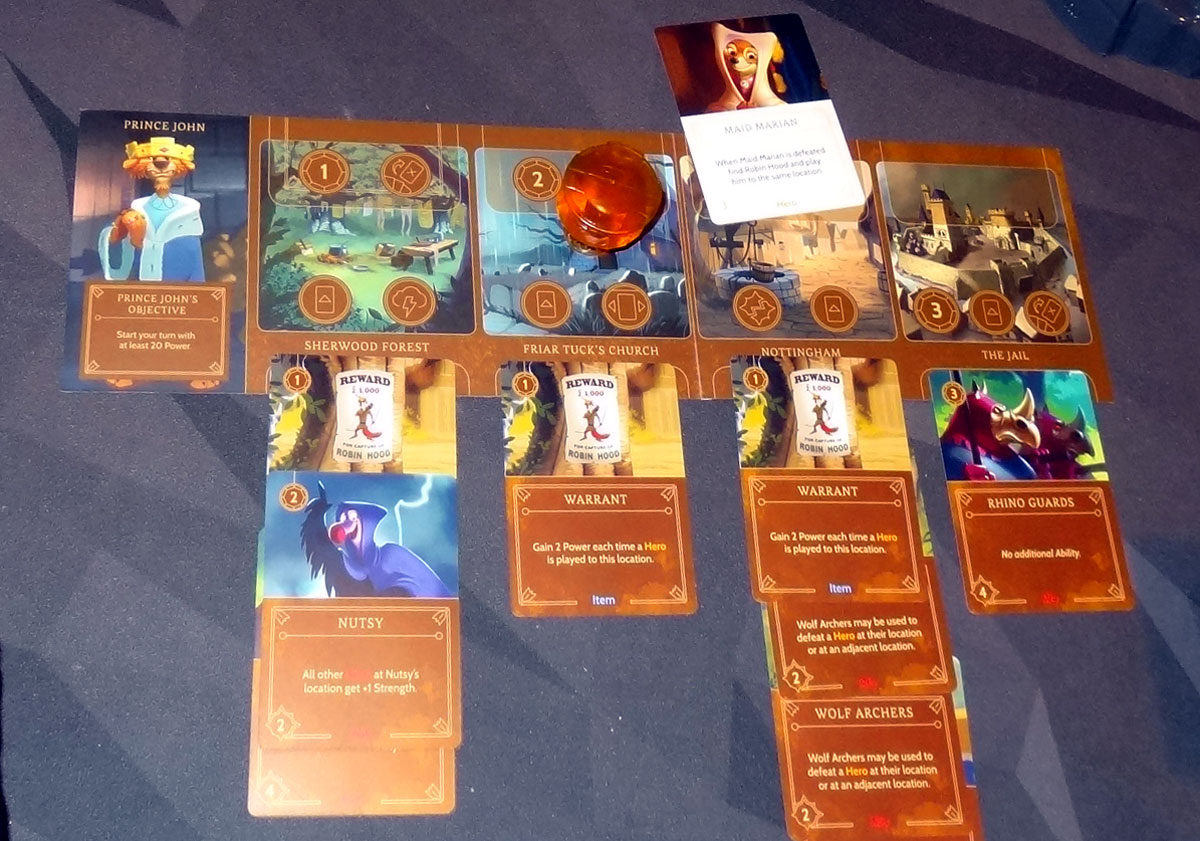
How to Play Villainous
You can download a copy of the rulebook here.
The Goal
Each villain has a unique objective, shown on their card:
- Captain Hook: Defeat Peter Pan at the Jolly Roger
- Jafar: Hypnotize the Genie and get the lamp to the Sultan’s Palace
- Maleficent: Have Curses in all of your locations
- Prince John: Amass 20 power
- Queen of Hearts: Have Wickets in all of your locations, and make the shot
- Ursula: Get King Triton’s trident and crown to your lair
The first villain to achieve their objective wins.
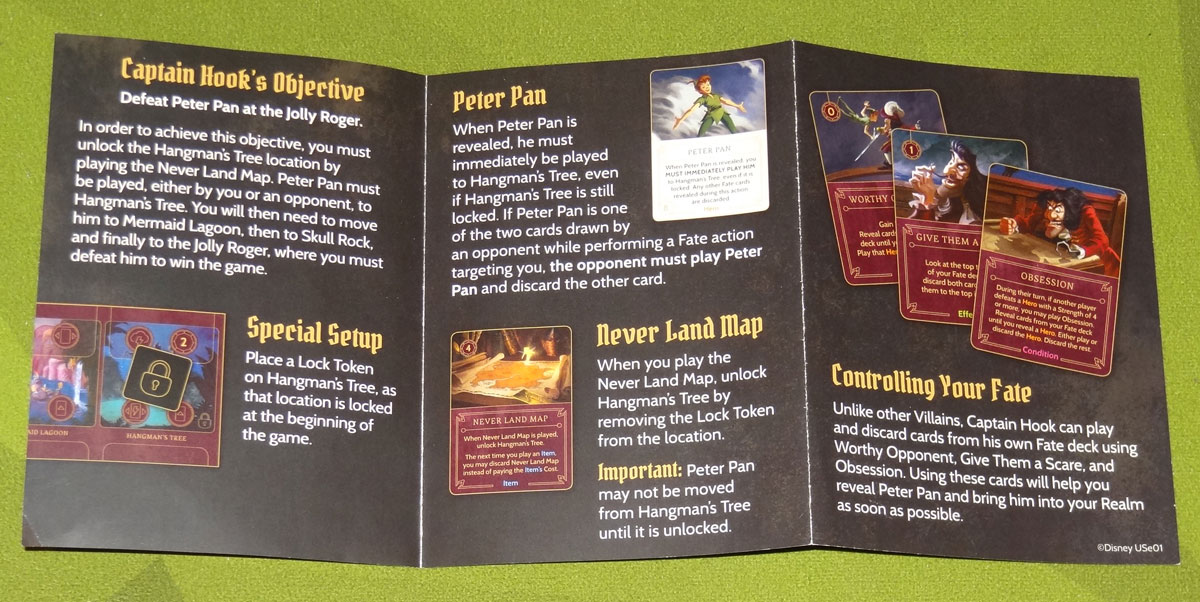
Setup
Give each player a character sheet, figure, and cards (villain cards and fate cards). Shuffle your two decks separately and place them next to your board, and place your figure on the left-most location on your board. If your right-most location has a lock icon on it, take a lock token and place it on that location.
Choose a starting player, who does not start with any power. The second player starts with 1 power, the third player starts with 2 power, and so on. Place the supply of power tokens in the cauldron where everyone can reach.
Make sure there is room above and below your player board for cards to be played to them. Draw 4 cards from your villain deck.
Finally, be sure to give each player the villain guide for their character. This little pamphlet isn’t just for flavor; it explains some of the rules and cards specific to your character, and explains your objective in a little more detail. The first time I played, I didn’t look at all of these too carefully, and some of the players missed important rules that were character-specific but weren’t in the overall rulebook.
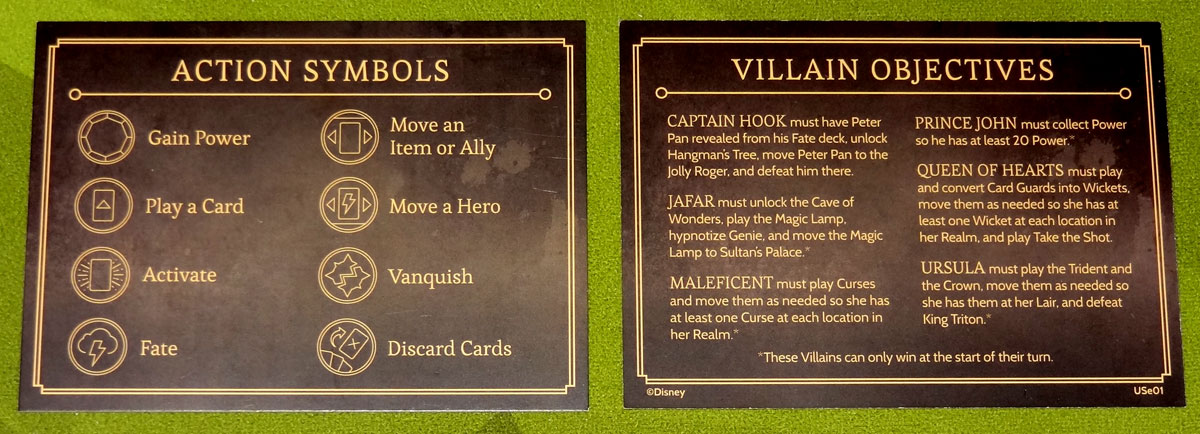
Gameplay
On your turn, you must move your figure to another (unlocked) location. Then you get access to all of the actions shown at that location, which you may take in any order. You are allowed to forfeit actions that you don’t wish to take. (Note that not all players have all of these actions on their boards.)
- Gain Power: take power from the cauldron equal to the number shown.
- Play a card: Pay power (shown at the top left of the card) to play a card.
- Activate: Some cards have an “activate” symbol on them—you must use an activate action to use the card’s ability.
- Fate: Draw 2 cards from another player’s fate deck, and choose one to play, if possible, and discard the other.
- Move Item or Ally: Move an item or ally on your side of the board left or right one space.
- Move a Hero: Move a Hero on your board left or right one space.
- Vanquish: Use allies and items to defeat a hero at the same location.
- Discard Cards: Discard any number of cards from your hand.
At the end of your turn, you draw back up to 4 cards.

While every villain has cards that are unique to them, they mostly share a common set of card types.
Your villain deck usually contains these types:
- Ally: Allies are played to the bottom half of your board, and have a strength value shown at the bottom left for use in vanquishing heroes. Some allies have additional abilities.
- Item: Items are played to the bottom half of your board and have varying effects. Some items are “attached” to allies, typically giving them more strength.
- Effect: When you play an effect, just do what it says, and then discard the card.
- Condition: When another player meets the condition shown on this card, you may play it out of turn to get the listed effect. Conditions are not played on your turn, and do not require a “play card” action to use.
Your fate deck contains these types:
- Hero: Hero cards are played to the top half of your board, and cover up the action icons there, preventing you from taking those actions. Heroes typically have other effects that come into play as well.
- Item: Items from your fate deck are played to the top half of your board, but are similar to your own items.
- Effect: Do what the card says, and then discard it.
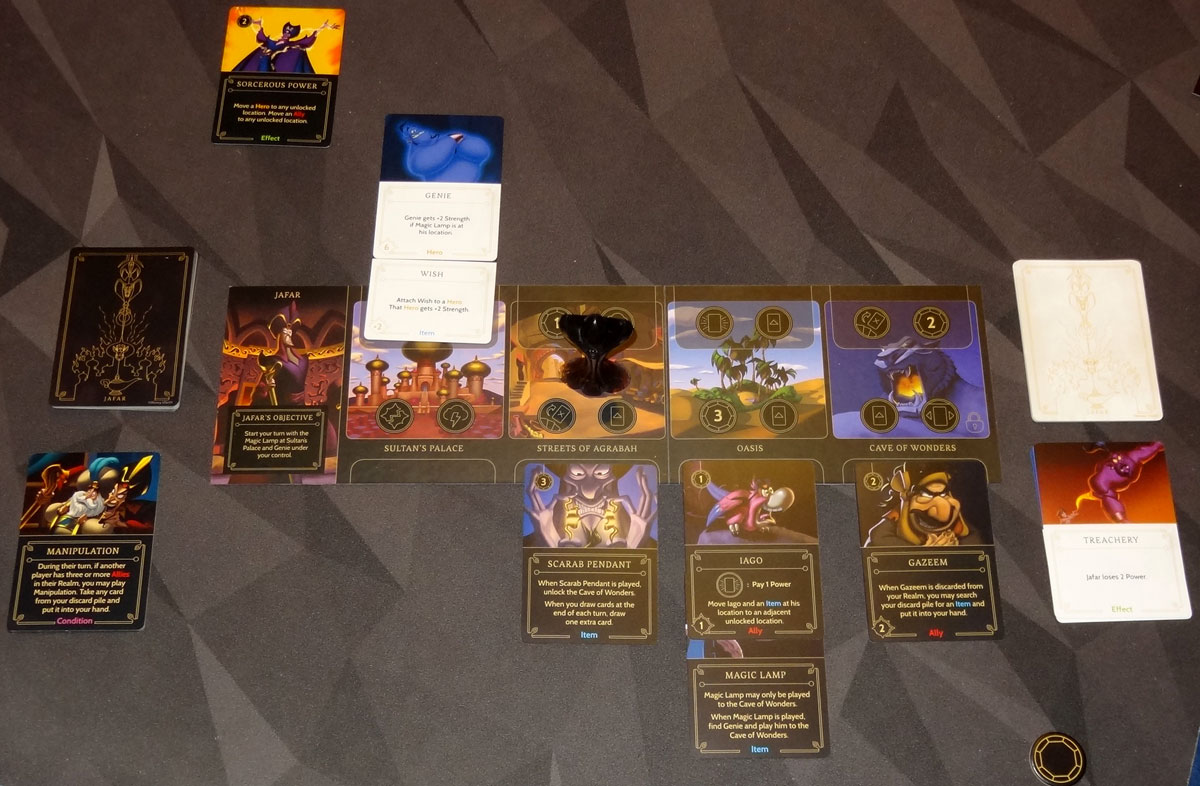
Heroes are quite annoying—they show up on your board, covering up your actions and often doing other terrible things to foil your plans. Typically, to get rid of a hero, you must have allies and items that add up to at least the hero’s strength in the same location. Then you use the vanquish action, which discards the hero and the allies/items used to defeat it. There are some exceptions, though: many players have effects that can discard heroes. Jafar has a hypnotize effect that brings the hero down to his side of the board and turns it into an ally. Ursula isn’t a fighter—instead, she uses binding contracts to assist those poor, unfortunate souls. Prince John can throw people into jail, which doesn’t negate their effects, but his jail location doesn’t have any actions that are covered up by heroes.
Game End
The game ends when any villain achieves their objective. Note that some of the objectives are achieved only at the start of a player’s turn. For instance, Prince John wins if he starts his turn with 20 power, not if he manages to accumulate it during his turn.

Why You Should Play Villainous
The first time I remember stopping to consider the Bad Guy’s point of view was in reading The True Story of the Three Little Pigs by A. Wolf, the book that launched the successful team of Jon Scieszka and Lane Smith. In it, the Wolf (not so Big and Bad, he claims) explains how his actions were totally misinterpreted, and that he just wants to set the story straight. Since then, I’ve seen this phenomenon much more: Gregory Maguire’s Wicked series (and the musical it inspired), Soon I Will Be Invincible (one of my favorite superhero novels, which is half narrated by Doctor Impossible), and there’s even a set of YA books based on Disney villains by Serena Valentino. And, of course, who could forget the “Bad-Anon” scene from Wreck-It Ralph?
Of course, playing the villain in board games is nothing new: whether it’s a historical wargame or a fantasy realm, there are lots of games in which you get to play as characters typically considered the antagonists. In The Neverland Rescue, one player gets to play as Captain Hook and his band of pirates, trying to catch Peter Pan. But Villainous does something new: it brings together a bunch of Disney villains from different films, and pits them in a race to accomplish their dastardly plans. Sure, it’s re-writing history a little, but sometimes you gotta give these evildoers a leg up.
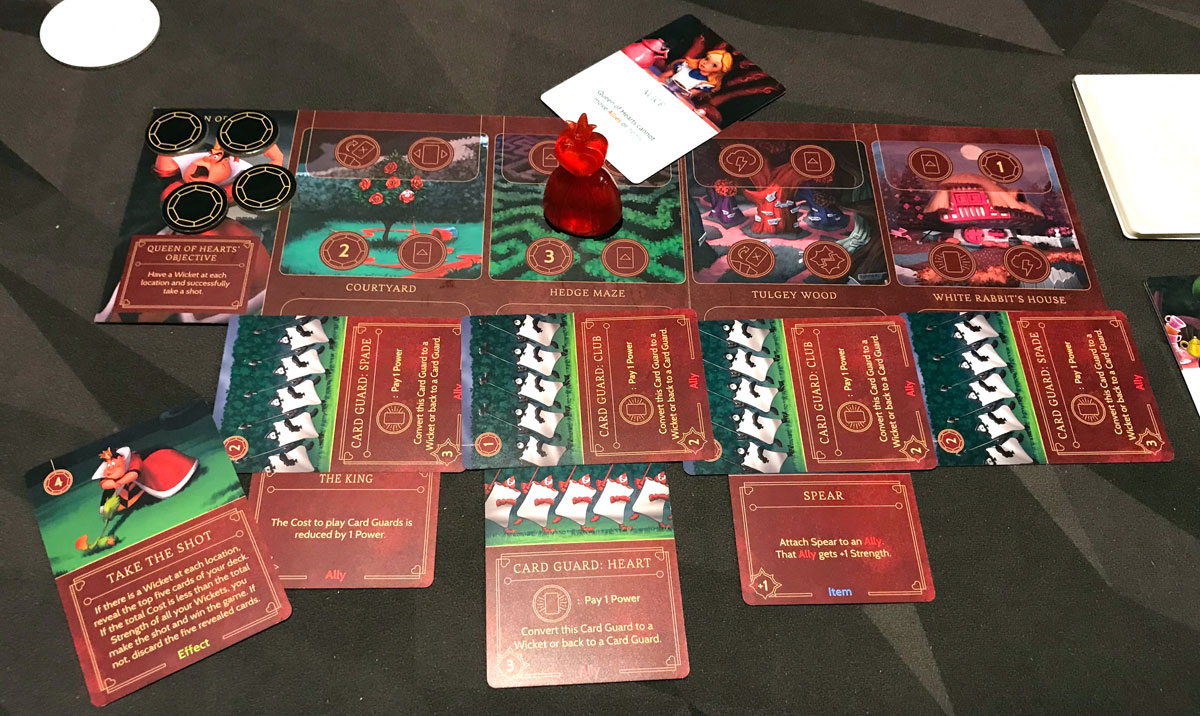
While your cards (both villain and fate cards) are only played to your own realm, there is still player interaction because other players can play fate cards to interfere with you. I like the feeling that it’s not that the villains are antagonizing each other directly, but that fate action represents the heroes from your film showing up to take action. So while it looks at first glance like everyone is just managing their own area, you still need to pay attention to what your opponents are doing. It is, however, something that players need to be deliberate about. If you’re too focused on your own realm, wanting to maximize your actions, you may not choose the location that lets you play fate cards—but that means other players may run away with the victory before you notice. If you wait until somebody is ahead before playing fate cards on them, they might build up too much momentum to stop.
I love the way that each villain feels different to play, because of the cards that are in their decks. The Queen of Hearts has cards that can shrink or grow heroes: small heroes only cover up one of the two actions on the location, but big heroes cover three. Captain Hook has item cards that actually add action icons to a location, making those locations more powerful. Maleficent’s Raven can fly to a location and take one action each turn, which can be extremely powerful when used properly.
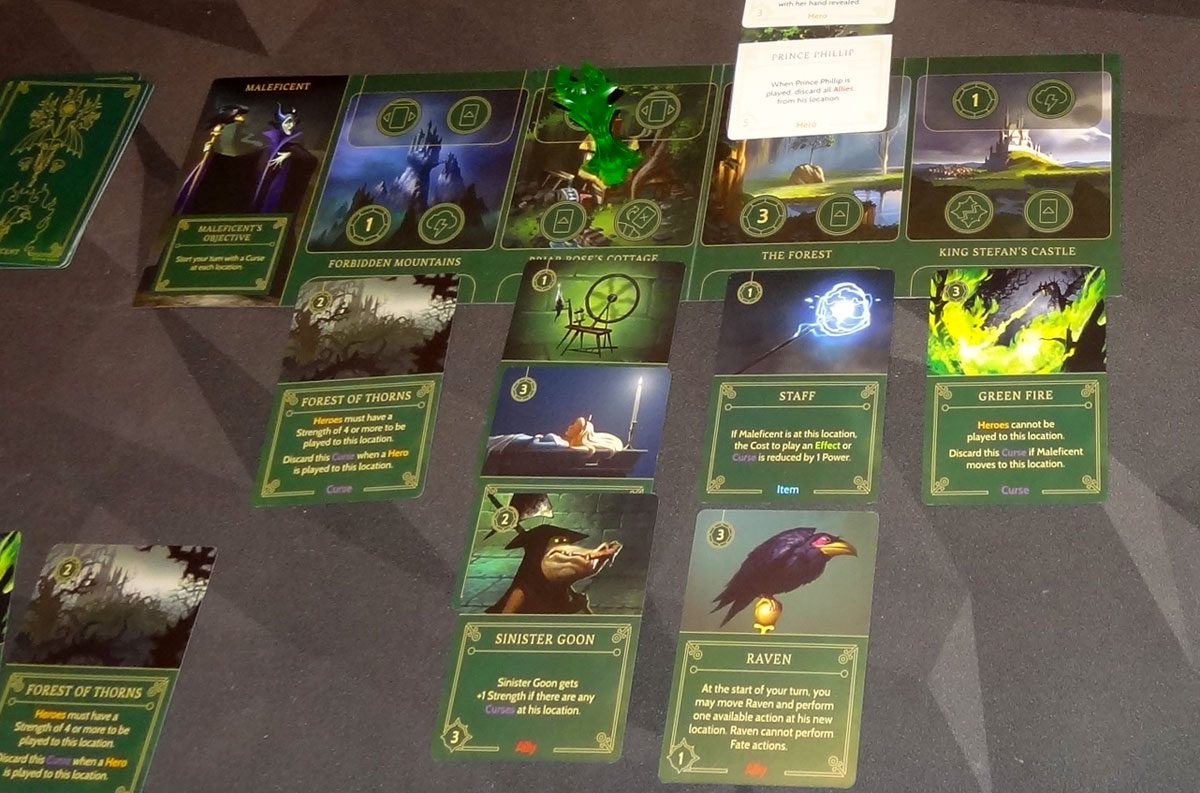
The first two times I played, we all just dove into the game without looking too carefully at our decks and what was in them, just to let the game be a surprise. And it was: heroes would show up and do things that astounded us. We played effects that caught other players off-guard. However, the game becomes much richer and more strategic once you know what’s possible, so don’t let your first play define the experience. The one thing I realized is that, at least for some characters, it’s important to discard cards you’re not using immediately, so that you can dig for the cards you actually want first, because you’ll eventually reshuffle your deck. With a hand size of only four cards, you can’t always afford to hang onto something for several turns, hoping that the right moment turns up.
The game does get a bit lengthy with more players—there’s just more downtime between turns, and not every turn will affect you. The Condition cards are a nice way to get you to pay attention to other players, because you have to watch what they’re doing to play your card, but each villain only has so many of those. The rest of the time, you’re mostly watching to see if anyone plays a fate card on you. Despite that, I did enjoy the wacky chaos that ensued in our five-player game, and a few of the players came close to winning by the end.
With fewer players, it can feel a bit more strategic, because you either move yourself forward or hinder your opponent. With more players, there can often be a bit of negotiation: you want to play out your own plans, but you’re counting on one rival to stop the other. Sometimes it works; sometimes it backfires.
The choice of villains seemed a little odd to me, particularly Prince John, simply because when you think of iconic Disney villains he’s not necessarily the one you’d come up with. (Though I did have at least one friend who was ecstatic that Prince John was included.) Notably missing were Scar from The Lion King and Cruella de Vil from 101 Dalmatians (though her shadow appears on the back of the rulebook—perhaps a hint at things to come? Both of them seem like stronger personalities than Prince John, though we decided it may be because their objectives might be a bit gruesome for kids to play out: having Mufasa killed or amassing 101 dalmatian pelts. Still, maybe we’ll see them at some point in the future, if the base game does well.
If you love Disney movies (and especially if you have a soft spot for the bad guys), you’ll get an evil cackle from Villainous. Look for it in stores starting August 1.
Click here to see all our tabletop game reviews.
![]() To subscribe to GeekDad’s tabletop gaming coverage, please copy this link and add it to your RSS reader.
To subscribe to GeekDad’s tabletop gaming coverage, please copy this link and add it to your RSS reader.
Disclosure: GeekDad received a copy of this game for review purposes.
